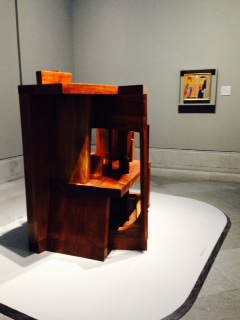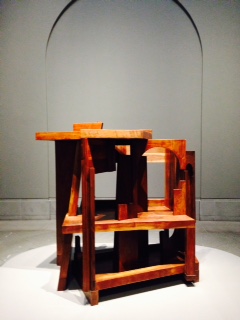AUGUST CHALLENGE DAY 12
For the Silly Season I've set myself the challenge of visiting a different art exhibition on every day of the month and blogging about it.
Wednesday 12 August
Exhibition: Art in Dialogue, Duccio and Caro
Place: Room 66, The National Gallery, London
The National Gallery guards are on strike, and quite rightly. By a disgraceful decision of the Trustees, they are due to be privatized and transferred to the employment of Securitas, a company better known for guarding asylum seekers and prisoners than priceless paintings. I’ve been in a few strikes myself and, approaching Trafalgar Square, decided I wouldn’t cross in the unusual event of a picket line in front of the Gallery. But it was late in the day and the pickets had gone home, so I went in. With a skeleton staff in place many galleries were closed but Room 66 with its two works “in dialogue” was open.

The works are the Annunciation by the Sienese religious painter Duccio, who died in 1319, and a walk-around sculpture by Anthony Caro, who died two years ago. At first sight the pairing looks incongruous. The Duccio is small, refined, delicately coloured and, above all, figurative, while the Caro is big, blocky and abstract. But it’s worth looking closer.
Duccio The Annunciation
An important feature of Duccio’s image is the representation of architecture. These arches and enclosures don’t just allow him to strengthen the illusion of 3-dimensions in the image, but are a stage set, defining the roles of the two figures and subtly enhancing the drama they play out. Mary is inside an enclosure of her own, and this is white, a reference to her virginity. The Archangel who comes to inform her that she is to bear the son of God in her womb, is shown coming in from a golden place to a human one – the act of crossing being emphasized by the forward moving posture and the way he goes through the arch. The theological symbolism is lightly handled but it is profound: the entry of the spirit of God into human flesh. Other Annunciations often represented this by a cartoony dotted line in gold, or a scroll with Gabriel’s words written on it. This is clunky compared to Duccio’s symbolic economy.
 Anthony Caro Duccio Variations No. 3
Anthony Caro Duccio Variations No. 3
It is Duccio's architecture to which the Caro sculpture most clearly responds. The artist usually made constructions in steel, but this work, made in 2000, is in walnut wood, as beautifully jointed and proportioned as any piece of domestic furniture – you might be looking at a deconstructed sideboard, say. But Caro’s arches and apertures are also meant to correspond specifically to Duccio’s, with the Virgin’s apartment on the right, and the strong diagonal on the left representing Gabriel.
Room 66 lies at the end of a sequence of rooms showing early Renaissance paintings and I notice that most visitors use this little display as a turning-point in their tour. They stroll into the small area of Room 66, swing around the sculpture and exit, flicking a glance at the Duccio as they go by. They really would do better to stay a little and look properly.